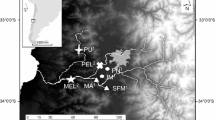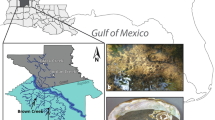Abstract
Intense selection on isolated populations can cause loss of genetic diversity, which if persistent, reduces adaptive potential and increases extinction probability. Phenotypic evidence of inherited tolerance suggests that polychlorinated biphenyls (PCBs), have acted as strong selective agents on populations of a non-migratory fish, Fundulus heteroclitus, indigenous to heavily contaminated sites. To evaluate population genetic structure and test for effects of intense, multi-generational PCB contamination on genetic diversity, we used AFLP analysis on fish collected from six sites along the east coast of North America that varied widely in PCB contamination. The sites included a heavily contaminated urban harbor (New Bedford, MA), an adjacent moderately contaminated sub-estuary (Buzzards Bay, MA), and an uncontaminated estuary 60 km away (Narragansett, RI). AFLP markers distinguished populations at moderate and small scales, suggesting genetic differentiation at distances of 2 km or less. Genetic diversity did not differ across the study sites. Genome-wide diversity may have been preserved because of large effective population sizes and/or because the mechanism for genetic adaptation to these contaminants affected only a small number of loci. Alternatively, loss in diversity may have been restored with moderate levels of migration and relatively short generation time for this species.


Similar content being viewed by others
References
Antonovics J, Bradshaw AD, Turner RG (1971) Heavy metal tolerance in plants. In: Cragg JB (ed) Advances in ecological research, vol 7. Academic Press, London, pp 1–85
Bagley MJ, Anderson SL, May B (2001) Choice of methodology for assessing genetic impacts of environmental stressors: polymorphism and reproducibility of RAPD and AFLP fingerprints. Ecotoxicology 10:239–244
Baker R, Lavie B, Nevo E (1985) Natural selection for resistance to mercury pollution. Experientia 41:697–699
Baquero F, Blazquez J (1997) Evolution of antibiotic resistance. Trends Ecol Evol 12:482–487
Benton MJ, Diamond SA, Guttman SI (1994) A genetic and morphometric comparison of Helisoma trivolvis and Gambusia holbrooki from clean and contaminated habitats. Ecotoxicol Environ Safe 2:20–37
Black DE, Gutjahr-Gobell R, Pruell RJ, Bergen B, Mills L, McElroy AE (1998a) Reproduction and polychlorinated biphenyls in Fundulus heteroclitus (Linnaeus) from New Bedford Harbor, Massachusetts, USA. Environ Toxicol Chem 17:1405–1414
Black DE, Gutjahr-Gobell R, Pruell RJ, Bergen B (1998b) Effects of a mixture of non-ortho and mono-ortho-polychlorinated biphenyls on reproduction in Fundulus heteroclitus (Linnaeus). Environ Toxicol Chem 7:1396–1404
Brown BL, Chapman RW (1991) Gene flow and mitochondrial DNA variation in the killifish, Fundulus heteroclitus. Evolution 45:1147–1161
Buntjer JB, Otsen M (1999) Cross checker provides computer-assisted marker interpretation. J Agric Genom, http://www.cabi-publishing.org/jag/papers99/paper599/indexp599.html
Butner A, Brattsrom BH (1960) Local movement in Menidia and Fundulus. Copeia 2:139–141
Coustau C, Chevillon C, French-Constant R (2000) Resistance to xenobiotics and parasites: can we count the costs? Trends Ecol Evol 15:378–383
Crow JF (1957) Genetics of insect resistance to chemicals. Annu Rev Entomol 2:227–246
Fisher RA (1930) The genetical theory of natural selection, 1st edn. Clarendon, Oxford
Foré SA, Guttman SI, Bailer AJ, Altfater DJ, Counts BV (1995) Exploratory analysis of population genetic assessment as a water quality indicator. I. Pimephales notatus. Ecotoxicol Environ Safe 30:24–35
Frankham R (1995) Effective population size/adult population size ratio in wildlife: a review. Genet Res 66:95–107
Gillespie RB, Guttman SI (1999) Chemical-induced changes in the genetic structure of populations: effects on allozymes. In: Forbes VE (ed) Genetics and ecotoxicology. Taylor and Francis Inc., Philadelphia, pp 55–77
Hahn ME (1998) The aryl hydrocarbon receptor: a comparative perspective. Comp Biochem Physiol Part C 121:23–53
Hedgecock D (1994) Does variance in reproductive success limit effective population sizes of marine organisms? In: Beaumont AR (ed) Genetics and evolution of aquatic organisms. Chapman & Hall, London, pp. 122–134
Hedrick PW (1999) Highly variable loci and their interpretation in evolution and conservation. Evolution 53:313–318
Heithaus MR, Laushman RH (1997) Genetic variation and conservation of stream fishes: influence of ecology, life history, and water quality. Can J Fish Aquat Sci 54:1822–1836
Keklak MM, Newman MC, Mulvey M (1994) Enhanced uranium tolerance of an exposed population of eastern mosquitofish (Gambusia holbrooki Girard 1859). Arch Environ Contam Toxicol 27:20–24
Klerks PL, Levinton JS (1989) Rapid evolution of metal resistance in a benthic oligochaete inhabiting a metal-polluted site. Biol Bull 176:135–141
Kneib RT (1986) The role of Fundulus heteroclitus in salt marsh trophic dynamics. Am Zool 26:259–269
Kopp RL, Guttman SI, Wissing TE (1992) Genetic indicators of environmental stress in central mudminnow (Umbra limi) populations exposed to acid deposition in the Adirondack Mountains. Environ Toxicol Chem 11:665–676
Lande R, Shannon S (1996) The role of genetic variation in adaptation and population persistence in a changing environment. Evolution 50:434–437
Lavie B, Nevo E (1986) Genetic selection of homozygote allozyme genotypes in marine gastropods exposed to cadmium pollution. Sci Total Environ 57:91–98
Leamon JH (1999) Gene flow and migration in populations of Fundulus heteroclitus macrolepidotus located in southeastern Connecticut. Masters thesis, University of Connecticut, Storrs, CT, USA
Leonard AC, Franson SE, Hertzberg VS, Smith MK, Toth GP (1999) Hypothesis testing with the similarity index. Mol Ecol 8:2105–2114
Long ER, MacDonald DD, Smith SL, Calder FD (1995) Incidence of adverse biological effects within ranges of chemical concentrations in marine and estuarine sediments. Environ Manage 19:81–97
Lotrich VA (1975) Summer home range and movements of Fundulus heteroclitus (Pisces: Cyprinodontidae) in a tidal creek. Ecology 56:191–198
Lynch M (1990) The similarity index and DNA fingerprinting. Mol Biol Evol 7:478–484
Lynch M (1991) Analysis of population genetic structure by DNA fingerprinting. In: Burke T, Dolf G, Jeffreys AJ, Wolff R (eds) DNA fingerprinting: approaches and applications. Birkhauser-Verlag, Basel, Switzerland, pp 113–126
Lynch M, Milligan BG (1994) Analysis of population genetic structure with RAPD markers. Mol Ecol 3:91–99
Mariette S, Le Corre V, Austerlitz F, Kremer A (2002) Sampling within the genome for measuring within-population diversity: trade-offs between markers. Mol Ecol 11:1145–1156
Martinez DE, Levinton J (1996) Adaptation to heavy metals in the aquatic oligochaete Limnodrilus hoffmeisteri: evidence for control by one gene. Evolution 50:1339–1343
McKenzie JA, Batterham P (1994) The genetic, molecular and phenotypic consequences of selection for insecticide resistance. Trends Ecol Evol 9:166–169
Meyer JN, DiGiulio RT (2003) Heritable adaptation and fitness costs in killifish (Fundulus heteroclitus) inhabiting a polluted estuary. Ecol Appl 13:490–503
Miller RG (1981) Simultaneous statistical inference, 2nd edn. Springer-Verlag Inc., New York
Mitton JB (1997) Selection in natural populations. Oxford University Press, Oxford
Moran MD (2003) Arguments for rejecting the sequential Bonferroni in ecological studies. Oikos 100:403–405
Mueller UG, Wolfenbarger LL (1999) AFLP genotyping and fingerprinting. Trends Ecol Evol 14:389–394
Mulvey M, Newman MC, Vogelbein WK, Unger MA (2002) Genetic structure of Fundulus heteroclitus from PAH-contaminated and neighboring sites in the Elizabeth and York Rivers. Aquat Toxicol 61:195–209
Mulvey M, Newman MC, Vogelbein WK, Unger MA, Ownby DR (2003) Genetic structure and mtDNA diversity of Fundulus heteroclitus populations from polycyclic aromatic hydrocarbon-contaminated sites. Environ Toxicol Chem 22:671–677
Murdoch MH, Hebert PDN (1994) Mitochondrial DNA diversity of brown bullhead from contaminated and relatively pristine sites in the great lakes. Environ Toxicol Chem 13:1281–1289
Nacci DE, Coiro L, Champlin D, Jayaraman S, McKinney R, Gleason TR, Munns WR Jr, Specker JL, Cooper KR (1999) Adaptation of wild populations of the estuarine fish Fundulus heteroclitus to persistent environmental contaminants. Mar Biol 134:9–17
Nacci DE, Champlin D, Coiro L, McKinney R, Jayaraman S (2002a) Predicting the occurrence of genetic adaptation to dioxin-like compounds in populations of the estuarine fish Fundulus heteroclitus. Environ Toxicol Chem 21:1525–1532
Nacci DE, Kohan M, Pelletier M, George E (2002b) Effects of benzo[a]pyrene exposure on a fish population resistant to the toxic effects of dioxin-like compounds. Aquat Toxicol 57:203–215
Nadig SG, Lee KL, Adams SM (1998) Evaluating alterations of genetic diversity in sunfish populations exposed to contaminants using RAPD assay. Aquat Toxicol 43:163–178
Nei M (1975) Molecular population genetics and evolution. North Holland Publishing Co., Amsterdam
Nei M (1978) Estimation of average heterozygosity and genetic distance from a small number of individuals. Genetics 89:583–590
Nelson WG, Bergen BJ, Benyi SJ, Morrison G, Voyer RA, Strobel CJ, Rego S, Thursby G, Pesch CE (1996) New Bedford Harbor long-term monitoring assessment report: baseline sampling. US Environmental Protection Agency, National Health and Environmental Effects Research Laboratory, Atlantic Ecology Division, Narragansett, RI. EPA/600/R-96/097
Powers DA, Ropson I, Brown DC, Van Beneden R, Cashon R, Gonzalez-Villasenor LI, DiMichele JA (1986) Genetic variation in Fundulus heteroclitus: geographic distribution. Am Zool 26:131–144
Pruell RJ, Norwood CB, Bowen RD, Boothman WS, Rogerson PF, Hackett M, Butterworth B (1990) Geochemical study of sediment contamination in New Bedford Harbor, Massachusetts. Mar Environ Res 29:77–101
Roark SA, Nacci D, Coiro L, Champlin D, Guttman SI (2005) Population genetic structure of a nonmigratory estuarine fish (Fundulus heteroclitus) across a strong gradient of polychlorinated biphenyl contamination. Environ Toxicol Chem 24:717–725
Safe S (1994) Polychlorinated biphenyls (PCBs): environmental impact, biochemical and toxic responses, and implications for risk assessment. Crit Rev Toxicol 24:87–149
Staton JL, Schizas NV, Chandler GT, Coull BC, Quattro JM (2001) Ecotoxicology and population genetics: the emergence of “phylogeographic and evolutionary toxicology”. Ecotoxicology 10:217–222
Street GT, Lotufo GR, Montagna PA, Fleeger JW (1998) Reduced genetic diversity in a meiobenthic copepod exposed to a xenobiotic. J Exp Mar Biol Ecol 222:93–111
Sweeney J, Deegan L, Garritt R (1998) Population size and site fidelity of Fundulus heteroclitus in a macrotidal saltmarsh creek. Biol Bull 195:238–239
Taylor MH, DiMichele L (1983) Spawning site utilization in a Delaware population of Fundulus heteroclitus (Pisces: Cyprinodontidae). Copeia 19:291–297
Taylor M, Feyereisen R (1996) Molecular biology and evolution of resistance to toxicants. Mol Biol Evol 13:719–734
Theodorakis CW (2001) Integration of genotoxic and population genetic endpoints in biomonitoring and risk assessment. Ecotoxicology 10:245–256
Theodorakis CW, Shugart LR (1997) Genetic ecotoxicology II: population genetic structure in mosquitofish exposed in situ to radionuclides. Ecotoxicology 6:335–354
Vos P, Hogers R, Bleeker M, Reijans M., van de Lee T, Hornes M, Frijters A, Pot J, Peleman J, Kuiper M, Zabeau M (1995) AFLP: a new technique for DNA fingerprinting. Nucleic Acids Res 23:4407–4414
Waples RS (1998) Separating the wheat from the chaff: patterns of genetic differentiation in high gene flow species. J Hered 89:438–450
Ward RD, Woodwark M, Skibinski DOF (1994) A comparison of genetic diversity levels in marine, freshwater, and anadromous fishes. J Fish Biol 44:213–227
Whitehead A, Anderson SL, Kuivila KM, Roach JL (2003) Genetic variation among interconnected populations of Catostomus occidentalis: implications for distinguishing impacts of contaminants from biogeographical structuring. Mol Ecol 12:2817–2833
Wright S (1943) Isolation by distance. Genetics 28:114–138
Wright S (1978) Evolution and the genetics of populations. In: Variability within and among natural populations, Vol 4. University of Chicago Press, Chicago
Acknowledgments
This work was performed while AM held a National Research Council Research Associateship. Statistical assistance and advisement was provided by A. Leonard, SoBran, and S. Franson, NERL, US EPA. Thanks to D. Champlin, NHEERL, US EPA for fish collections. Much appreciated reviews were provided by T. Gleason, J. Markert, and S. Roark and two anonymous reviewers. Special thanks to M. Duboise and S. Pelsue in the University of Southern Maine for providing workspace for some of this work.
Author information
Authors and Affiliations
Corresponding author
Additional information
This is contribution number AED-05-096 of the US EPA ORD NHEERL Atlantic Ecology Division. Although the research described in this contribution has been funded partially by the US EPA, it has not been subjected to Agency-level review. Therefore, it does not necessarily reflect the views of the agency. Mention of trade names, products, or services does not constitute endorsement or recommendation for use.
Rights and permissions
About this article
Cite this article
McMillan, A.M., Bagley, M.J., Jackson, S.A. et al. Genetic diversity and structure of an estuarine fish (Fundulus heteroclitus) indigenous to sites associated with a highly contaminated urban harbor. Ecotoxicology 15, 539–548 (2006). https://doi.org/10.1007/s10646-006-0090-4
Accepted:
Published:
Issue Date:
DOI: https://doi.org/10.1007/s10646-006-0090-4




